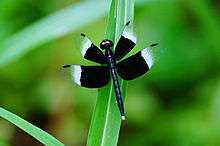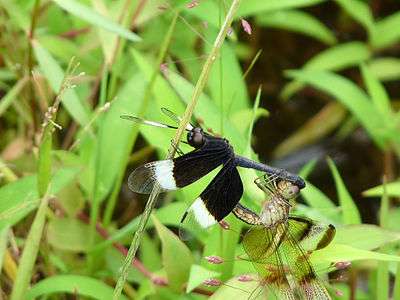Neurothemis tullia
Neurothemis tullia,[2] the pied paddy skimmer,[3][4] is a species of dragonfly found in south and south-east Asia. It appears in Bangladesh, China, Hong Kong, India, Malaysia (Peninsular Malaysia), Myanmar, Nepal, Sri Lanka, Taiwan, Thailand, Cambodia and Viet Nam.[1][5]
| Pied paddy skimmer | |
|---|---|
 | |
| Male | |
_female.jpg) | |
| Female | |
| Scientific classification | |
| Kingdom: | |
| Phylum: | |
| Class: | |
| Order: | |
| Suborder: | |
| Family: | |
| Genus: | |
| Species: | N. tullia |
| Binomial name | |
| Neurothemis tullia (Drury, 1773) | |
| Synonyms | |
| |
Description and habitat
It is a black dragonfly with a pale yellow mid-dorsal carina of thorax. Wings are hyaline for apical half and opaque steely blue-black for basal half which is bordered by a milky white patch towards the tip. Females differ remarkably from the males both in body-colouring and markings and in marking of the wings. Its body is greenish yellow with a bright yellow mid-dorsal carina of thorax. Base of wings are amber yellow followed by a blackish brown patch. Apices of all wings are broadly opaque blackish brown and the reaming halves are pale yellow.[6][7][8][3][4]
It breeds in marshes, well vegetated ponds, lakes and rice fields. It perches very close to ground and its flight is very weak.[6][8]
_immature_male.jpg) Young male
Young male- Male
_male_2.jpg) male
male_female_2.jpg) female
female Mating pair
Mating pair
See also
- List of odonates of Sri Lanka
- List of odonates of India
- List of odonata of Kerala
References
- Dow, R.A. (2009). "Neurothemis tullia". IUCN Red List of Threatened Species. 2009: e.T163754A5646477.
- Martin Schorr; Dennis Paulson. "World Odonata List". University of Puget Sound. Retrieved 12 October 2018.
- "Neurothemis tullia Drury, 1773". India Biodiversity Portal. Retrieved 18 March 2017.
- "Neurothemis tullia Drury, 1773". Odonata of India, v. 1.00. Indian Foundation for Butterflies. Retrieved 18 March 2017.
- K.A., Subramanian; K.G., Emiliyamma; R., Babu; C., Radhakrishnan; S.S., Talmale (2018). Atlas of Odonata (Insecta) of the Western Ghats, India. Zoological Survey of India. pp. 344–345. ISBN 9788181714954.
- C FC Lt. Fraser (1936). The Fauna of British India, including Ceylon and Burma, Odonata Vol. III. Red Lion Court, Fleet Street, London: Taylor and Francis. pp. 360-362.
- C FC Lt. Fraser (1924). A Survey of the Odonate (Dragonfly) Fauna of Western India and Descriptions of Thirty New Species (PDF). p. 437.
- Subramanian, K. A. (2005). Dragonflies and Damselflies of Peninsular India - A Field Guide.
External links
- Pied Parasol (Neurothemis tullia tullia) - Kalahe, Galle, Sri Lanka
- Md Rawi, Che Salmah (1996) Some Aspects of the Biology and Ecology of Neurothemis Tullia (Drury) (Odonata:Libellulidae) in the Laboratory and Rainfed Rice Field in Peninsular Malaysia. PhD thesis, Universiti Putra Malaysia.
![]()
![]()
